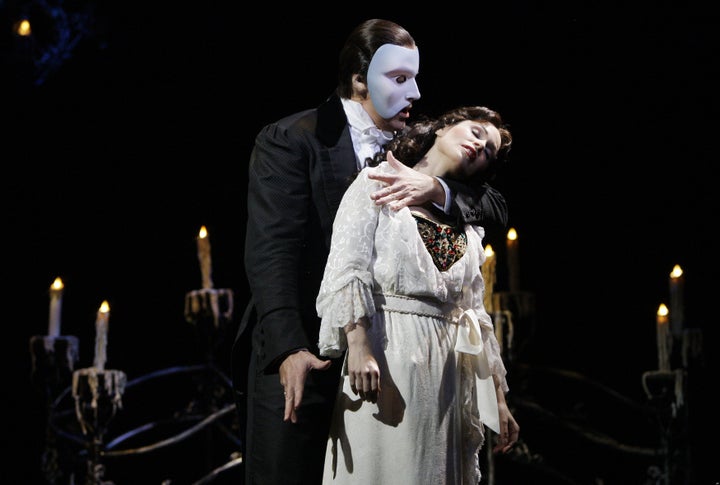
Back in 1988, when Phantom of the Opera debuted on Broadway beginning a historic run, New York Times' critics Frank Rich and Walter Kerr both reviewed the show. Rich's review ran first, in which he authoritatively stated, "Only a terminal prig would let the avalanche of pre-opening publicity poison his enjoyment of this show, which usually wants nothing more than to shower the audience with fantasy and fun, and which often succeeds, at any price."
Now 23 years later, I can attest that the show still manages to live up to the hype. What's so remarkable about Phantom is how much it accomplishes -- and surprises -- with such a simple narrative. Most musicals offer up a main story with a slew of side stories involving other characters and their own tensions and drama. Phantom, however, sticks to the lone storyline that even non-theatergoers can relate: A phantom haunts an opera house, while trying to make the production's lead performer his wife. That narrative dictates and determines everything else that happens in the show. Yet, despite the audience's prior familiarity with the show, it keeps you on the edge of your seat thanks to the incredible and impressive staging of the production.
Rich said in 1988 that "The physical production, Andrew Bridge's velvety lighting included, is a tour de force throughout -- as extravagant of imagination as of budget." That, too, remains true. I marveled more at the magnificently-detailed and well-constructed sets more than anything else in the show. Each time the curtain opened to reveal a new backdrop, it was a miraculous discovery. At time, it felt like you were sitting at a magic show, wondering how the producers pulled off such a quick set change or got all those candles onto the stage, or hid the phantom into pieces of scenery. Where he'd show up next was always a mystery that kept you on the edge of your seat.
This production has always featured these kinds of emotional thrills. In his review, Walter Kerr highlighted some moments that he believed failed to capture the suspense and hostility of some pivotal scenes. Kerr said:
But in the end ''The Phantom of the Opera'' can be no more than the sum of its pictorial effects. It's not opera (not with those bland melodies, not with lyric phrases like ''Be My Guest'' and ''Make My Night''), it's not a display case of serious acting, it's not humor (not even self-mockery). It's psychologically lightweight, long on melodramatic grotesquerie, and it can only live on its visual chills.
None of the examples of show shortcomings Kerr provided are still pressing issues, which means that at some point the production addressed whatever faults it was said to have. Today, this production conveys more than "visual chills," a product of more than just theatrical tinkering and improvements. While Phantom has long been considered a classic, I believe it has taken on more importance in this new generation as the bridge to the Broadway of the past. Its current popularity does not only reflect a built-in, avid audience of older theater lovers; younger people are turning out, too.
In recent years, we've seen more and more Broadway production incorporate elements of rock and popular music into their books. Phantom instead blends samplings from opera, a style of music that younger patrons may be hearing only for the first time. And it's all as pleasing and beautiful as the dancing and romantic gesturing you're witnessing in front of you. In that way, Phantom has over time retained everything that was once wonderful about it, and become something even more distinguished than it once was.
This article has been updated.